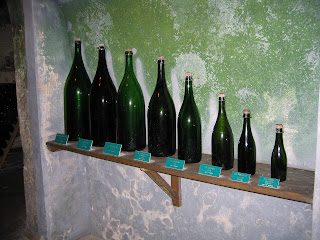
And while the church was beautiful and had some gorgeous stained glass windows, you don't go to Reims for the Giant European Church. You go for the champagne. First stop, the Taittinger Champagne House. The ground under the entire region is chalk, which is very easy to dig. At one point, the monks in the city had dug elaborate tunnels under the city, allowing them to move around undisturbed (sounds like crazy cool ninja monks to Rob). Now, every champagne house uses these caves to store their champagne as it ages. The tour is fascinating. The Taittinger House sits over 4 km of caves and those 4 km are stuffed with champagne bottles. The house itself only represents 10% of the storage space- the rest is stored and aged in other caves nearby.
After the grapes are harvested and fermented, they are aged anywhere between 15 months and 8 years, depending on whether or not they are vintage and the maker's own preference. At first, the wine is stored horizontally, separating the wine from the yeast sediment.

Once the sediment has settled, the bottles are moved into pupitres, which are the wooden boards shown here:

As the wine ages, the bottles are slowly turned and the angle of the pupitres are increased, ever-so-slowly sliding the sediment down to the top of the bottle. Oh, and the house has two guys whose sole job is to turn the bottles and they turn something like 6000 bottles an hour (the larger storage facility uses a machine). Once that process is completed, the end of the bottle is frozen, creating a small ice block, and the pressure then allows the expulsion of the sediment when the bottle is opened briefly. Then a small amount of wine and sugar (how much determines whether the champagne is a brut, sec, or demi-sec) is added and the wine is aged some more.
This mural shows three of the steps. The guy on the left is turning the bottles, the guy in the middle is disgorging the sediment (they still use candlelight to inspect the sediment), and the guy on the right is adding the wine and sugar.
Once the secret magic number is reached, the bottle is labeled and sold in one of these sizes (a normal bottle of champagne is the second one from the right):

After the tour, we had a tasting and, naturally, bought some champagne. There are several houses to visit in Reims, but we wanted to get out into the valley and check out some of the other towns, so we (sobered up and) headed south to Troyes...

No comments:
Post a Comment